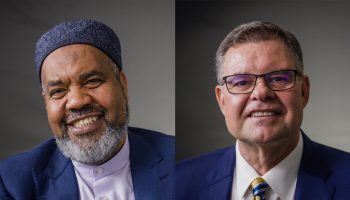
Columbia University’s Ari Goldman thinks that without religious literacy, a journalist runs the risk of misinforming the public.
“When done right, journalism can educate and inform the public,” Goldman said. “When done wrong, it can spread falsehoods and reinforce stereotypes.”
Goldman recorded his lecture, “From Church Stories to Obituaries, Journalists Need Religious Literacy,” on the lawn of his bungalow in the Catskill Mountains on July 26.
The lecture was released at 2 p.m. EDT Thursday, Aug. 6, on the CHQ Assembly Video Platform as part of the Week Six Interfaith Lecture Series theme “Lessons in the School House.” Audience members submitted questions through the www.questions.chq.org portal or on Twitter with #CHQ2020.
Religion news isn’t for the religion pages anymore,” Goldman said. “A sophisticated reporter knows that religion has a role in many of the great debates in our society, from abortion, to gay marriage, to healthcare, to housing, to education.”
Goldman had a consistent byline in The New York Times before he began teaching his Covering Religions course at Columbia University. He said that journalists often struggle with understanding the diversity within religions, much less the difference between them.
“People know about their own religion — well, sometimes — but people rarely know about others,” Goldman said.
In 2010, British TV host Kay Burley confused Joe Biden’s Ash Wednesday ashes for a bruise on his forehead.
“I’m a bad Catholic,” Burley said after producers informed her while she was still on air.
It’s just one example of why journalists need to understand religions to do full reporting. Goldman’s students have gone on to report on religion for the Chicago Tribune, the Miami Herald, the Atlanta Journal Constitution and other publications. For 12 years, his student Maria-Paz López covered the Vatican for La Vanguardia in Spain and is now the publication’s Berlin correspondent.
Goldman’s students have also gone on to cover other topics, including economics, health care, foreign policy, the White House and education, but he said they do so knowing the importance of religion in all parts of life.
“Religion news isn’t for the religion pages anymore,” Goldman said. “A sophisticated reporter knows that religion has a role in many of the great debates in our society, from abortion, to gay marriage, to healthcare, to housing, to education.”
Goldman referred to Harvard University’s Diana Eck, Professor of Comparative Religion and Indian Studies, who he studied with at Harvard Divinity School. She repeats this phrase often: “If you know one religion, you don’t know any.”
“She is telling us not to make assumptions about one religion based on our own,” Goldman said.
Catholic Confirmation is not the same as a Jewish Bar Mitzvah. While some religions consider hands joined together as prayerful, Buddhists consider them to represent the meeting of the finite and infinite.
The former cornerstone of journalism, Goldman said, was objectivity — but he teaches empathetic objectivity in his courses. Communion reported objectively is people eating wafers. With empathetic objectivity reporting, the journalist communicates that for the believer, this is a sacred act of taking the body of Christ.
The Scripps Foundation in Cincinnati, Ohio, has funded his class trips to Israel, Palestine, Russia, and Ukraine, where his students cover beat topics that center on different religious groups. His students have covered the last three Popes.
His spring 2020 class had planned to visit Louisiana and Mississippi to cover the diversity of religion in the U.S. South. But Columbia University shut everything down a few days before they were slated to leave on March 13.
The class pivoted to instead cover religious groups coping with the pandemic. His favorite story that came out of the course was a story on virtual water baptisms.
“The news changes, and we have to change, too,” Goldman said.
Goldman noted the increase of obituaries written worldwide with the onset of COVID-19. When deaths in the United States hit 100,000, The New York Times published 1,000 names of those who had died by coronavirus in the United States on the front page and started a new section, “Those We’ve Lost to the Coronavirus,” which is similar to the “Portraits of Grief” obituary section they published after 9/11.
And in China, independent blogs and news sites covered the deaths of workers on the front lines of the virus. Italy published between 10 and 12 pages of obituaries per day, and papers in Brazil and South Africa followed suit.
Along with empathetic objectivity, there was one last lesson Goldman said he imparts on his students.
“Every life is a story worth telling,” Goldman said.




